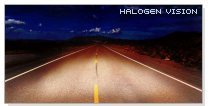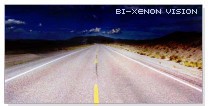HID TECHNOLOGY OVERVIEW
Summary
H.I.D. lighting system delivers instantaneously 3 times the light output of conventional halogen headlamp, consumes only 35-watt per capsule (VS. halogen's 55-watt per bulb), and has a life expectancy of 5 times longer (2500 hour to 3000 hour VS. 500 hr. or less). The luminous intensity and color of HID is truly like harnessing the brightness of the sun. You will be able to see further and wider ahead of you.
What is H.I.D.?
H.I.D. stands for High Intensity Discharge. It refers to lighting technology that relies on an electrical charge to ignite xenon gas contained in a sealed bulb (capsule). HID lighting doesn't have a filament but instead creates light by igniting an arc between two electrodes. HID lights get their name from the intense white light produced by the electrical discharge. HID lamps are also called xenon lamps, referring to a gas inside the lamps.


Is HID new?
HID lighting has been gaining ground over the past several years. HID lighting systems were first offered as an option on high-end luxury cars and are currently offered as standard equipment on 7% of all European vehicles. HID made its North American debut in 1995 on the Lincoln Mark VIII and today, HID headlights are available in the U.S. as an option on several different high-end models. Although halogen is still used on the majority of vehicles manufactured today, HID will continue to make headway due to its safety and performance benefits. Kits for additional vehicle models are continually in development.
Why HID?
Xenon headlamps are the best vehicle lighting currently available because they offer more light than conventional bulbs - and this in a quality similar to daylight. Some auto experts cite the almost complete darkness on isolated highways as a reason for why HID lighting is becoming popular. HID lights promote safety by providing a better overall view of the roadway and the ability to see upcoming objects quickly and more clearly. For example, road signs and objects on the road are easier to see when illuminated by HID headlights.
HID provides a better vision
It can be vital to see more in borderline situations. Because the risk of having an accident at night is about twice as high as during the day - despite the fact that there is less traffic on the road. The reason: humans are inadequately equipped to see at night or in poor weather conditions. The better you can see and the more similar the light conditions are to daylight, the better the compensation for the factors that make night driving difficult:
-
Overstimulation caused by the large number of traffic signs.
-
Reduction of visual acuity at night to one twentieth of the daytime level.
-
Loss of important information due to restricted field of vision, considerably reduced ability to recognise contrasts and colours.
-
Tiredness and decreasing concentration.
-
Diminishing powers of vision in the dark from 30 years of age onwards.
How is HID different?
HID lighting provides about three times the light output of standard halogen headlights while using less energy. HID lights are designed to last up to 5 times longer than standard halogen lamps.

HID is similar to daylight
Xenon bulbs offer more light than conventional bulbs and that in a quality similar to daylight. Ensuring more safety. Road illumination is brighter and wider with the xenon light which has a longer range. In particular, dangers at the curb areas as well as obstacles in front of the vehicle are recognized more quickly. Pedestrians or cyclists can also be seen better, as can traffic signs at the edge of the road. In poor weather conditions - such as rain, fog or snow - drivers also have much better spatial vision. This means that the orientation ability of drivers is less limited despite adverse conditions. Driving comfort is also improved. Because it is not the act of seeing itself which leads to tiredness and other negative effects, but the concentration involved. A road that is illuminated more brightly and widely by xenon light reduces the amount of concentration needed, so that drivers do not become tired as quickly and can concentrate on driving longer.
Once with HID, always with HID.
In 1997, the renowned opinion research institute Emnid carried out a survey among drivers whose vehicles were equipped with xenon light. The results of this survey speak for themselves:
| 94% | of all xenon users have a positive opinion of xenon light, the main features mentioned were brightness (42 %) and general illumination (35 %). |
| 85% | of all xenon users feel they could see better at night, with the age-group over 50 this figure even rose to 90 %. |
| 83% | of all xenon users would order their next car with xenon light again. |
| 80% | of all xenon users feel they can see better in the rain using xenon light. |
| 75% | of all xenon users state that the wider illumination of the road creates more safety for cyclists and pedestrians. |
| 64% | of all xenon users consider xenon light to be so good that it should be made standard for all vehicles. |
| 61% | of all xenon users feel safer with xenon light. |
Bi-Xenon HID (Dual beam HID) (Hi/Lo HID)
There are two versions of H4 Bi-Xenon Kit (Hi/Lo).
-
Low Beam HID/High Beam Halogen: This special dual-bulb version generates regular and high beams in one single base utilizing a HID capsule for the regular low beam and an H1 halogen for the high beam.
-
True Bi-Xenon Moving Mechanic: This is a single-capsule that generates regular low beam & high beam using the HID capsule patterns. This is done by using a movable shutter. It is more expensive due to the required controllers as mentioned above. But one's eyes see a constantly agreeable light and do not have to continually re-adapt between the two colors/intensities/clarities. Moreover, apart from the setting mechanism for the shutter, additional expenditure for a separate headlamp with its own control electronics is no longer necessary. This saves energy, money, construction space and weight, and helps reduce fuel consumption.
Is HID here to stay?
Experts indicate that automotive lighting will continue to evolve and HID lighting systems will displace the current halogen headlight technology. Experts further say that although it has been regarded as a luxury option or a prestige item, it will become a more common, expected and affordable feature. Projected worldwide HID usage is expected to exceed 10% of all vehicles by 2008.



